
Among the tide of post-war reconstruction that reshaped British cities, the work of Lyons Israel Ellis stands out for its architectural clarity and civic purpose. Wyndham Court, completed in 1966 for Southampton City Council, is one such example—its stepped, interlocking forms rising prominently beside Southampton Central railway station. Today, it endures not just as a Grade II listed structure but as a symbol of brutalist ambition woven into the fabric of everyday life.
My relationship with Wyndham Court extends beyond a photographer’s lens. While I’ve documented other post-war landmarks like the Ken Norrish Building in Portsmouth and the Southbank Centre in London, what distinguishes Wyndham Court is not only its form, but the intimacy of its function. For me, this is not just about cataloguing concrete; it's about bearing witness to the lived narratives that unfold behind it.
Like many buildings of its era, Wyndham Court is often met with polarised responses. Admiration for its sculptural geometry or dismissal for its austere palette. But these aesthetic arguments rarely touch on what I find most compelling: the subtleties of use, memory, and adaptation. Since the late 1960s, this building has been home to an ever-evolving community. Behind its facades those recessed balconies and ribbon-like fenestration are lives layered with history, routine, and reinvention.
In photographing Wyndham Court, I’m drawn less to symmetry or lighting and more to what architecture mediates. The site becomes a backdrop, yes, but also a vantage. Each window not only frames Southampton’s shifting skyline but also reflects the quieter transitions within—families arriving, relationships growing, spaces transforming. Picture three in my series captures this sentiment most vividly: not a dramatic perspective or pristine composition, but a simple moment that hints at presence unseen but palpable.
Wyndham Court is an architectural vessel, but it is also a social one. It invites us to reconsider our assumptions about uniformity and individuality, permanence and change. It reminds us that architecture is never static that buildings, however materially robust, are porous to time, culture, and care.
For architects, there’s a challenge here: how do we design with longevity not just in structure, but in spirit? How do we embrace buildings that may be controversial, yet are undeniably generative? Wyndham Court doesn’t offer definitive answers. What it offers is continuity. A place where brutalism meets belonging. And in today’s architectural landscape, that might be its most radical gesture of all.


